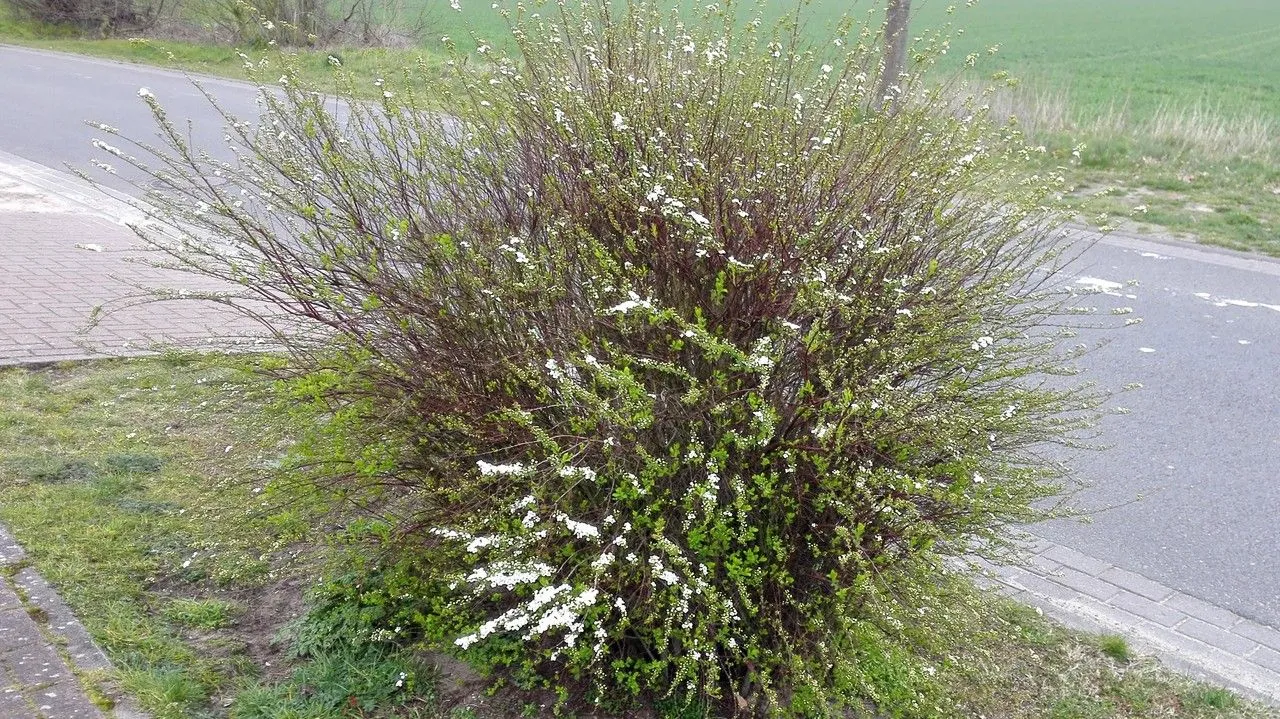
Author: L.
Bibliography: Sp. Pl.: 489 (1753)
Year: 1753
Status: accepted
Rank: species
Genus: Spiraea
Vegetable: False
Observations: S. Europe to Siberia and W. & C. Himalaya
The Iberian spirea, scientifically known as Spiraea hypericifolia, is a deciduous shrub belonging to the Rosaceae family. First documented in 1753 by the renowned botanist Carl Linnaeus, this elegant plant has long captivated botanists and horticulturists alike with its delicate beauty and hardy characteristics. Originating from Southern Europe, it spans a vast geographic range extending to Siberia and the Western and Central Himalayas.
Characterized by its arching branches and clusters of small, white flowers, the Iberian spirea offers a striking visual appeal during the blooming season. The flowers, appearing in dense, rounded clusters, present a frothy display that can add a touch of elegance to various garden settings. This robust shrub can thrive in a variety of soil types, making it a versatile addition to gardens and landscapes.
The resilience of Spiraea hypericifolia is notable, as it can withstand harsh climatic conditions ranging from the cold expanses of Siberia to the moderate climates of Southern Europe and the elevated terrains of the Himalayas. This adaptability makes it an excellent choice for gardeners looking to introduce a tough yet attractive plant to their collections.
In terms of growth and care, the Iberian spirea requires minimal maintenance once established. It prefers full sun to partial shade and well-drained soil. Regular pruning after the flowering period ensures the health and vigor of the plant, promoting better blooms in the subsequent seasons.
The historical and botanical significance of the Iberian spirea is also worth noting. Linnaeus’ inclusion of Spiraea hypericifolia in his seminal work “Species Plantarum” underscores its importance and recognition within the botanical community. Over centuries, this plant has been studied and cherished, not only for its ornamental value but also for its resilience and adaptability across diverse environments.
In summary, the Iberian spirea (Spiraea hypericifolia) is a versatile and attractive shrub that offers both aesthetic and practical benefits. Its ability to thrive in various climates and its minimal maintenance requirements make it a valuable addition to any garden or landscape.
Deu: hartheu-spierstrauch
Eng: iberian spirea
Lit: jonžolialapė lanksva
Ita: spirea spagnola
Swe: rysk spirea
En: Iberian spirea, Saint John’s Wort-leaved Spirea
Zh: Jin si tao ye xiu xian ju
Nl: Hertshooispirea
Fr: Spirée à feuilles de millepertuis
De: Hartheu-Spierstrauch, Johanniskrautblättriger Spierstrauch
It: Spirea spagnola
Lt: Jonžolialapė lanksva
Sv: Rysk spirea
Taken Dec 23, 2020 by Marco Angel (cc-by-sa)
Taken May 6, 2013 by Andrzej Konstantynowicz (cc-by-sa)
Taken Mar 19, 2020 by Sabina Hartmann (cc-by-sa)
Taken Aug 12, 2022 by Patrick (cc-by-sa)
Taken Apr 29, 2021 by M. R. Campoamor (cc-by-sa)
Taken Apr 18, 2022 by Les Chevaux ‘M (cc-by-sa)
Taken May 28, 2022 by оксана . (cc-by-sa)
Taken May 1, 2021 by Víctor Huete (cc-by-sa)
Taken Apr 29, 2021 by M. R. Campoamor (cc-by-sa)
Taken Apr 29, 2021 by M. R. Campoamor (cc-by-sa)
Taken May 1, 2022 by Yves MORENO (cc-by-sa)
Taken Apr 27, 2022 by Eric Pantaloni (cc-by-sa)
Taken Mar 5, 2022 by Stéphan Plisson-Sauné (cc-by-sa)
Taken Jun 2, 2018 by Tela Botanica − Hélène MUHLHOFF (cc-by-sa)
Taken Mar 19, 2020 by Sabina Hartmann (cc-by-sa)
Taken May 11, 2021 by Sylvain Piry (cc-by-sa)
Taken May 15, 2008 by Photoflora – Jean-Luc TASSET (©)
Taken Jan 1, 1970 by Photoflora – L’Abbé COSTE (©)
Taken Jul 10, 2022 by Sofia Engdahl (cc-by-sa)
Taken Jul 16, 2022 by Sofia Engdahl (cc-by-sa)
© copyright of the Board of Trustees of the Royal Botanic Gardens, Kew.
© copyright of the Board of Trustees of the Royal Botanic Gardens, Kew.
Growth habit>: Shrub
Ph maximum: 7.5
Ph minimum: 7.0
Light: 7
Atmospheric humidity: 5
Soil nutriments: 3
Family: Myrtaceae Author: (F.Muell.) K.D.Hill & L.A.S.Johnson Bibliography: Telopea 6: 402 (1995) Year: 1995 Status:…
Family: Rubiaceae Author: Pierre ex A.Froehner Bibliography: Notizbl. Bot. Gart. Berlin-Dahlem 1: 237 (1897) Year:…
Family: Sapindaceae Author: Koidz. Bibliography: J. Coll. Sci. Imp. Univ. Tokyo 32(1): 38 (1911) Year:…
Family: Asteraceae Author: A.Gray Bibliography: Pacif. Railr. Rep.: 107 (1857) Year: 1857 Status: accepted Rank:…
Family: Fabaceae Author: Medik. Bibliography: Vorles. Churpfälz. Phys.-Ökon. Ges. 2: 398 (1787) Year: 1787 Status:…
Family: Aspleniaceae Author: (Cav.) Alston Bibliography: Bull. Misc. Inform. Kew 1932: 309 (1932) Year: 1932…